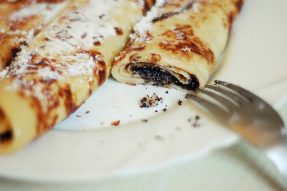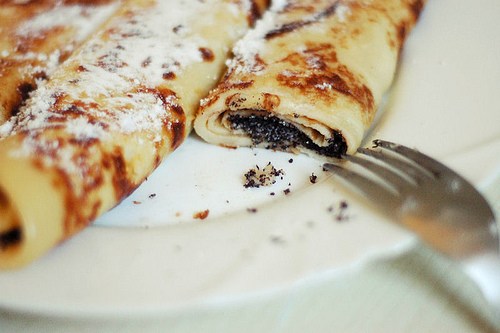
[The second half of my digression into Hungarian food will feature three desserts. Here’s the first!]
My father empties a small ladle-full of batter into a cast iron pan in quick circles. He adjusts the heat, picks up a long, thin spatula, and waits. He checks his watch, and then he slips the spatula under the thin pancake and flips it. In a minute or two, in one fluid motion, he scrapes the pancake out of the pan and flops it onto a growing stack of Palacsinta.
No Identity?
If there are two words I associate with Palacsinta (“pah-la CHIN-tah”), one of them is “patience.” Waiting for the pancake to cook, removing it to the stack, making the next one, beginning again, slowly building a pile. Perhaps there was no greater illustration of my father’s deep patience than his Palacsinta making.
The other word I associate with Palacsinta is, well, “limp.” On the face of it, Palacsinta is maddening. What is this thing? Spongier than a crêpe, and rolled, not folded like its French cousin, yet firmer and thinner than a blintz, Palacsinta appears to have no identity, no striking character. It could slide easily into obscurity, and often does, deservedly). I’m reminded of how the lunch special at Moca, a long-gone Hungarian restaurant on the Upper East Side, would conclude with a Palacsinta, dropped quickly on the table by the waiter, who seemed to want no responsibility for it. It was too small (they really should be six or seven inches in length) and the filling lacked personality.
While main dishes are a deserved source of pride (and calories!), in my opinion, the crown jewels of Hungarian cuisine may be found in its desserts. In some Hungarian desserts, the genius is plain and up-front, in others, it is quite literally wrapped inside. So it is with Palacsinta. The Palacsinta pancake is like an overcoat, a neutral cover that protects, and hides, the “filling,” the snazzy suit or gorgeous dress underneath. Its frumpy filling – bland, indifferent – is what made Moca’s Palacsinta so frustrating.
Chocolate And Vanilla We Get
My father made three types of Palacsinta filling: poppy seed (from his recipe: “Mak Toltelek”), walnut (“Dio Toltelek”), and cottage cheese (“Turos Toltelek”). The poppy seed was a salt-and-pepper mix of tiny black seeds and sugar. It was the oddest to me and I never ate poppy seed Palacsinta back then. I preferred the sugary, lemony, chopped walnuts. I went back and forth on the sweetened cottage cheese, unsure quite what to make of it, but eventually loving it.
A central aspect of the genius of Hungarian dessert fillings is their unusual palette. Unusual to an American, that is. When it comes to dessert, what most Americans do not understand is subtlety. Chocolate and vanilla we get, so long as they are delivered in familiar forms such as ice cream or cake. The lemony tang, crunch, and slight sweetness of chopped walnut filling, the lumpy-soft sweetness of cottage cheese filling, or flavors used in other Hungarian desserts, including chestnut or almond paste, take time for an American to come to appreciate. But once one does so, there is no turning back. These flavors open new territories of enjoyment, new levels and complexities.
For me the final frontier was poppy seed, perhaps second only to paprika as the national flavor of Hungary. How I hated poppy seed when I was growing up. And how my father loved it. Alone, it had the dark aftertaste of licorice or cigarettes. I turned up my nose even when it was sufficiently sugared. “So uncouth!” my father would shout, as I sat savoring my Hostess cupcake (remove the top, roll it into a ball and save it for later) or Suzy Q (once around the cream filling with the tongue before the first bite). My father’s admonition was partly pleasure in seeing his son enjoy a sinful treat. But he also must have felt a kind of sadness at how little could be translated to his children, from Hungarian to American. Its strange flavors contributed to a sense of distance I felt about Hungary, and to some extent about my father, when I was growing up.
Pulled From The Freezer And Warmed In The Oven
During the time that I was writing about him, and coming to understand and relate to him more subtly as I myself entered middle age, I grew a taste for poppy seed and I began to eat poppy seed desserts. The strudel was too much for me, with a ratio of poppy seed to dough of easily 10 to 1. My preference was for the poppy seed Hamentashen (not particularly Hungarian, I know), where I could cut and balance the strong, complex filling with the neutral cookie.
I had settled in New York by then, and later moved uptown near the Hungarian Pastry Shop with my young family. As we would prepare to drive down to visit my parents in Maryland, my father would ask me (and remind me multiple times) to bring along several slices of poppy seed strudel, one of which he would consume almost immediately upon our arrival.
I picture him at the kitchen table some weeks later, unwrapping the foil around the poppy seed strudel he has just pulled from the freezer and warmed in the oven. And as I see the flashes of ecstasy on his face as he savors it, I appreciate the full power of Hungarian dessert filling, and my own limitations. Even as I have come to appreciate their flavors and textures to a degree I never would have expected, there is a wide gap between the depth and breadth of pleasure an American convert to Hungarian dessert feels when he eats it, and that which a native Hungarian does.
Buy the book, Finding Maria (Bloomingdale Press – 2nd edition November 25, 2019), on Amazon
(Photo credit: https://greathungarianplain.wordpress.com/2012/01/22/sunday-brunch-makos-palacsinta/)

